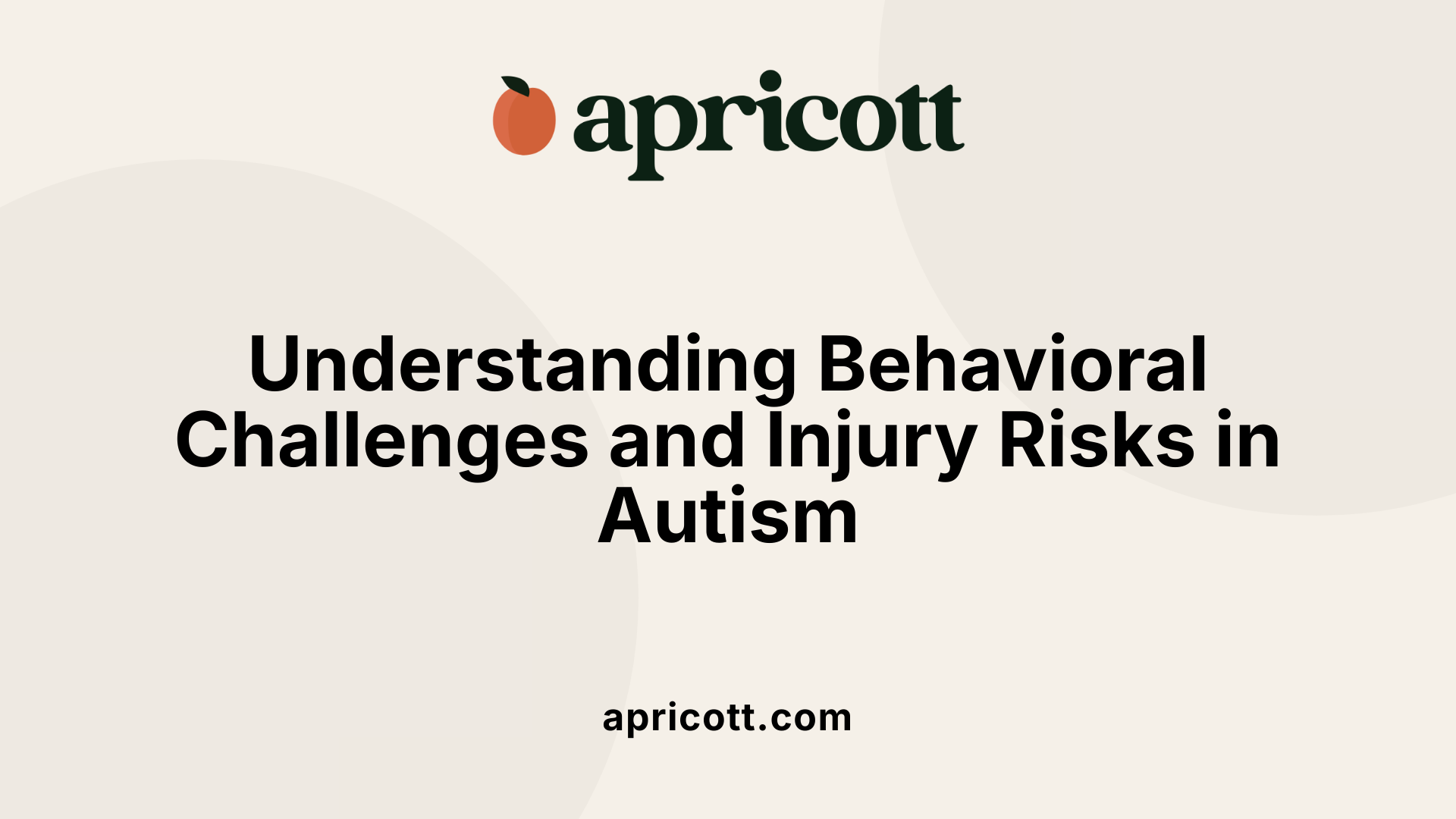Exploring the Link Between Autism and Injury Risk
Autism Spectrum Disorder (ASD) is characterized by a wide variety of behavioral and developmental features. Among the concerns for caregivers and professionals alike is the question of whether autistic individuals experience higher rates of injury. This inquiry prompts an exploration into the nature of problem behaviors common in ASD, their potential to increase risk, and the role of therapeutic interventions such as Applied Behavior Analysis (ABA) in mitigating harm and promoting safety.
Behavioral Challenges in Autism and Their Impact on Injury Risk

Do autistic individuals experience problem behaviors that may increase injury risk?
Children with Autism Spectrum Disorder (ASD) and intellectual disabilities often display problem behaviors such as self-injury, aggression, pica (ingesting non-food items), disruptive behavior, and elopement (wandering away).
These behaviors are not only prevalent but can also be severe and persistent, posing significant safety concerns. For example, self-injury and aggression can lead to physical harm, while elopement increases the risk of accidents or getting lost.
Prevalence of problem behaviors in ASD
Research shows that children with ASD combined with intellectual disabilities have higher rates of these challenging behaviors compared to those without intellectual disabilities. The presence of intellectual disability further elevates the risk and intensity of such behaviors.
Types of problem behaviors influencing injury rates
- Self-injury: Actions like head-banging or biting can cause serious physical injury.
- Aggression: Can harm both the individual and others around them.
- Pica: Ingesting harmful substances can lead to poisoning or internal injury.
- Disruption: Can lead to unsafe situations due to impulsivity.
- Elopement: Poses dangers related to wandering away from safe environments.
Relationship between severity of disability and behaviors
There is a strong correlation between the severity of a child's disability and the likelihood of severe problem behaviors occurring. More significant disabilities tend to be associated with increased rates of aggression and elopement.
This relationship underscores the need for tailored interventions that consider the intensity of the disability to reduce both behavioral challenges and injury risk. Families and caregivers often face considerable stress and increased care demands due to these behaviors, highlighting their profound impact on quality of life.
Quality of Life and the Consequences of Problem Behaviors

How do problem behaviors affect the quality of life for autistic individuals and their families?
Children with Autism Spectrum Disorder (ASD) who also have intellectual disabilities often experience higher rates of severe problem behaviors such as self-injury, aggression, pica, disruptive behaviors, and elopement. These behaviors significantly impair their quality of life and create considerable challenges for their families.
Problem behaviors can lead to increased family stress and emotional strain, diminishing overall well-being. The severity and chronic nature of these behaviors can necessitate more intensive support services and interventions, which compounds the impact on daily living.
To manage these challenges, families and caregivers often resort to restrictive methods, including environmental limitations, and there is a tendency toward over-prescription of medication to control behaviors. While these interventions might reduce immediate risks, they can introduce additional side effects and raise ethical concerns about autonomy and the child’s emotional health.
Furthermore, the increased support needs place substantial demands on healthcare systems and social services, affecting resource availability and long-term planning for affected individuals and their families.
Applied Behavior Analysis (ABA): Foundations and Role in Autism Support
What is applied behavior analysis (ABA) therapy and how does it help individuals with autism?
Applied Behavior Analysis (ABA) therapy is a scientific approach grounded in operant conditioning, focusing on how environmental factors shape behaviors. It involves identifying the reasons behind specific behaviors through functional behavior assessment, then applying tailored interventions.
ABA helps children with autism by using positive reinforcement to encourage adaptive skills like communication and social interaction. It aims to reduce problem behaviors such as aggression and self-injury, common in children with autism and intellectual disabilities, thereby improving their quality of life.
Principles and goals of ABA
ABA emphasizes individualized treatment plans focused on building from a child's strengths and interests. Modern ABA uses naturalistic, play-based methods rather than rigid, repetitive drills. Its goals include promoting independence, enhancing participation in daily activities, and supporting neurodiversity by respecting each child's unique traits.
How ABA helps autistic individuals
Through systematic reinforcement, ABA encourages skill acquisition and reduces harmful behaviors. Evidence from randomized controlled trials supports its effectiveness in decreasing the severity and frequency of problem behaviors. It is flexible, with programs ranging from comprehensive long-term interventions to short-term, problem-specific approaches.
Importantly, ABA does not seek to change the child's identity but to empower them, making learning enjoyable while building communication and social skills. Therapy intensity is tailored, typically between 10 to 20 hours per week, ensuring it meets each child's specific needs while avoiding undue pressure.
Techniques and Goals in ABA Therapy for Behavior Management
What are the common goals and techniques used in ABA therapy for autism?
Applied Behavior Analysis (ABA) therapy aims to improve communication, social skills, daily living activities, and academic performance in children with autism spectrum disorder (ASD), while also reducing harmful behaviors such as aggression or self-injury.
ABA utilizes several key techniques, including positive reinforcement to encourage desirable behaviors by rewarding them immediately. Prompting and fading help children learn new skills step-by-step, gradually reducing assistance to promote independence. Behavior chaining breaks complex tasks into smaller, manageable steps taught sequentially.
The ABC model—Antecedent-Behavior-Consequence—is central to behavior analysis in ABA. It involves identifying the specific events or triggers (antecedents) before a behavior, observing the behavior itself, and analyzing the reinforcing consequences that maintain it. This helps in tailoring intervention strategies to each child's unique needs.
Goal setting in ABA is highly individualized. Therapists conduct functional behavior assessments to understand why a problem behavior occurs and design personalized plans that focus on skill-building rather than simply suppressing behavior. The overarching aim is to foster adaptive, meaningful skills that enhance the child's participation and quality of life.
Modern ABA emphasizes naturalistic and play-based learning over repetitive drills, making sessions more engaging and promoting generalization of skills beyond therapy settings. Typically, therapy intensity ranges from 10 to 20 hours per week, adjusted according to the severity and needs of the child, ensuring balanced support without overwhelming demands.
By focusing on both behavior reduction and meaningful skill acquisition grounded in operant conditioning principles, ABA remains a scientifically supported approach to helping children with ASD achieve greater independence and improved daily functioning.
The Professionals Behind ABA Therapy: Training and Expertise

Who Typically Provides ABA Therapy and How Are These Professionals Trained?
ABA therapy is primarily provided by board-certified behavior analysts (BCBAs) and registered behavior technicians (RBTs). These professionals undergo extensive preparation to ensure they deliver effective, evidence-based interventions tailored to children with autism spectrum disorder (ASD) and intellectual disabilities (ID).
Types of ABA Providers
- Board-Certified Behavior Analysts (BCBAs): Specialists who design, supervise, and evaluate ABA programs. They hold graduate degrees in behavior analysis or related fields and are responsible for individualized treatment planning.
- Registered Behavior Technicians (RBTs): Paraprofessionals who implement ABA strategies under the supervision of BCBAs. RBTs work directly with the child using behavior guidance methods.
Training and Certification Requirements
To become a BCBA, candidates must complete a graduate-level course sequence in behavior analysis, accumulate supervised practical experience, and pass the Behavior Analyst Certification Board (BACB) exam. RBTs require completion of a training course, hands-on supervised experience, and passing a competency assessment.
Ongoing Professional Development
ABA providers engage in continuous education to keep abreast of advances in behavior analysis, ethical practices, and person-centered approaches. This ongoing learning ensures that interventions remain aligned with contemporary, respectful, and effective techniques—such as play-based naturalistic methods that focus on the child’s strengths and preferences rather than outdated aversive techniques.
Maintaining certification involves periodic renewal with evidence of professional development hours, safeguarding high standards in therapy delivery and supporting better outcomes for children with ASD and ID.
Family Involvement and Support in ABA Therapy
How can families support individuals undergoing ABA therapy?
Families play a vital role in augmenting the effectiveness of ABA therapy for children with ASD and intellectual disabilities. Active participation of family members in therapy sessions helps ensure consistency in reinforcement strategies, which is crucial for the generalization and maintenance of learned skills.
One important approach is training families in basic ABA principles, enabling them to apply reinforcement techniques at home. This might include praising or rewarding desired behaviors, using prompts to encourage skills, and collaborating with therapists to set realistic, person-centered goals.
Strategies for reinforcement at home
Implementing reinforcement strategies at home often involves creating structured routines that incorporate skill practice and positive reinforcement. For example, families can celebrate small achievements by providing preferred rewards or engaging in enjoyable activities, helping to motivate the child continuously.
Maintaining a supportive environment also means recognizing and responding appropriately to problem behaviors without relying on punitive methods. This fosters a positive atmosphere conducive to learning and emotional well-being.
Overcoming barriers to parental involvement
Barriers such as parental stress, cultural differences, and logistical challenges can impede active family involvement. Addressing these barriers includes offering flexible therapy schedules, culturally sensitive communication, and support systems to reduce stress.
Encouraging open communication between therapists and families builds trust and reinforces shared commitment to the child's development.
By embracing these strategies, families become empowered partners in ABA therapy, significantly contributing to positive outcomes and enhanced quality of life for the child.
Modern ABA Practices: From Controversies to Person-Centered Approaches

How has ABA therapy evolved to address criticisms and support neurodiversity?
ABA therapy has undergone significant transformation since its inception in the 1960s. Early methods, popularized by Dr. Ivar Lovaas, controversially included aversive techniques such as electric shocks and intensive, repetitive training aimed primarily at eliminating unwanted behaviors. These practices have been widely discredited and are no longer part of contemporary ABA.
Shift to naturalistic, play-based methods
Today, ABA is largely centered on naturalistic, play-based interventions rather than the traditional Discrete Trial Training (DTT). This modern approach emphasizes reinforcing skills during engaging, meaningful activities within the child’s everyday environment, promoting generalization of learning and greater joy in participation.
Focus on neurodiversity and individualized goals
Modern ABA prioritizes respect for neurodiversity and is tailored to the unique strengths and interests of each child. Rather than aiming to make autistic children indistinguishable from their peers, current practices help build independence, communication, and social participation. Therapy intensity is adjusted based on individual needs, typically ranging from 10 to 20 hours per week.
Overall, the evolution of ABA reflects a move from rigid behavior suppression to supportive interventions that enhance quality of life, honor personal identity, and foster inclusion in society.
Reducing Injury Risk Through Behavior Assessment and Intervention

What is the role of functional behavior assessment (FBA)?
Functional behavior assessment (FBA) is a crucial approach used to identify the environmental triggers and reinforcements that maintain problem behaviors, such as self-injury and aggression, commonly seen in children with autism spectrum disorder (ASD) and intellectual disabilities. By understanding these factors, caregivers and therapists can tailor interventions that directly address the reasons behind harmful behaviors.
How do individualized interventions help reduce harmful behaviors?
Interventions based on FBA are personalized to each child's unique situation and behavior patterns. Applied behavior analysis (ABA), which uses evidence-based techniques rooted in operant conditioning, is a primary intervention method informed by FBA. ABA interventions can be comprehensive, targeting broad skills over time, or problem-focused, zeroing in on specific harmful behaviors. This individualized approach helps replace dangerous behaviors with functional alternatives, enhancing safety and quality of life.
What evidence supports the reduction of injury-related behaviors?
Extensive empirical research, including randomized controlled trials and single-case experimental designs, substantiates the effectiveness of ABA-driven, function-based treatments in decreasing the severity and frequency of harmful behaviors. These approaches have been shown to improve communication and social skills, leading to less reliance on restrictive management methods and medications. By focusing on each child's specific needs and motivations, these interventions substantially reduce injury risk and improve family outcomes.
Balancing Intensity and Individual Needs in ABA Implementation
What is the typical intensity and duration of ABA therapy?
ABA therapy sessions for children with ASD and intellectual disabilities typically range from 10 to 20 hours per week. This is considerably less than some earlier models that suggested up to 40 hours weekly. The actual hours are adjusted based on the individual child's needs and severity of behavior challenges, ensuring that therapy remains manageable and meaningful.
How is ABA customized to severity?
Therapy intensity and focus are tailored to each child’s severity of disability and specific problem behaviors. For example, children exhibiting severe aggression or elopement may require more targeted, problem-focused interventions, while others might benefit more from comprehensive programs focused on broader skill development. This customization helps maximize benefit without overwhelming the child.
How does ABA avoid excessive demands?
Modern ABA practices prioritize naturalistic, play-based methods over rigid, repetitive tasks. This approach reduces the risk of therapy becoming too demanding. Therapists emphasize learning in enjoyable contexts, building on a child’s strengths and interests. The goal is to promote independence and participation while respecting neurodiversity, rather than suppressing behaviors indiscriminately. By balancing structure with flexibility, ABA avoids causing undue stress or fatigue.
Through careful adjustment of therapy intensity and individualized planning, ABA seeks to deliver effective support that respects each child's unique profile and promotes quality of life.
Conclusion: Enhancing Safety and Quality of Life for Autistic Individuals
What are the behavioral risks and how can interventions help?
Children with autism spectrum disorder (ASD) and intellectual disabilities often face severe behavioral challenges, such as aggression, self-injury, and elopement. These behaviors greatly reduce their quality of life and increase dependence on restrictive management and medication. However, interventions like Applied Behavior Analysis (ABA), grounded in functional behavior assessment, offer effective strategies to reduce problem behaviors and teach adaptive skills.
Why is individualized and respectful treatment essential?
Modern ABA emphasizes play-based, naturalistic approaches tailored to each child’s unique needs, strengths, and interests. This person-centered focus avoids outdated and controversial practices that attempted to suppress neurodiverse expressions or used aversive methods. Instead, it aims to enhance independence, communication, and joyful participation in social settings while respecting neurodiversity.
How do families and professionals collaborate in supporting autistic individuals?
Successful outcomes rely on strong partnerships between families and professionals. By working together, they develop personalized, evidence-based interventions that consider the severity of disabilities and family circumstances. This collaborative approach ensures that supports foster safety, dignity, and improved quality of life for autistic children and their communities.
Towards Safer and More Supportive Environments
While autistic individuals, particularly those with intellectual disabilities, may face higher risks of injury related to behaviors such as self-injury and elopement, evidence-based interventions like Applied Behavior Analysis provide effective pathways to reduce these risks. Modern, person-centered ABA practices focus on building strengths, promoting independence, and honoring neurodiversity, thereby improving safety and enhancing quality of life. Collaboration among trained professionals, families, and communities is essential to creating supportive environments where autistic individuals can thrive safely and with dignity.
References
- Treatment of severe problem behaviour in children with ...
- The Controversy Around ABA
- Does Applied Behavior Analysis (ABA) Cause Trauma?
- How to Become an ABA Therapist - School of Education
- How to Become an Applied Behavior Analyst (ABA) Therapist
- The Role of Caregiver Involvement in ABA Therapy
- Helping Parents Understand Applied Behavior Analysis
- Parent Involvement in ABA Therapy
.svg)
.svg)








